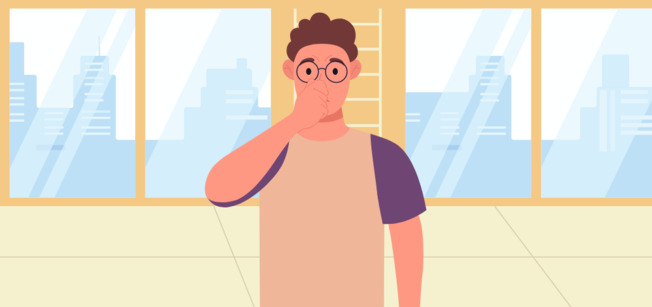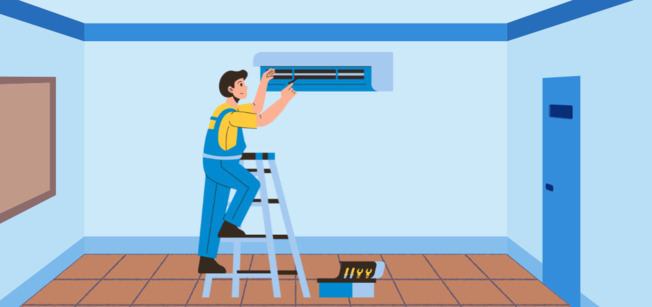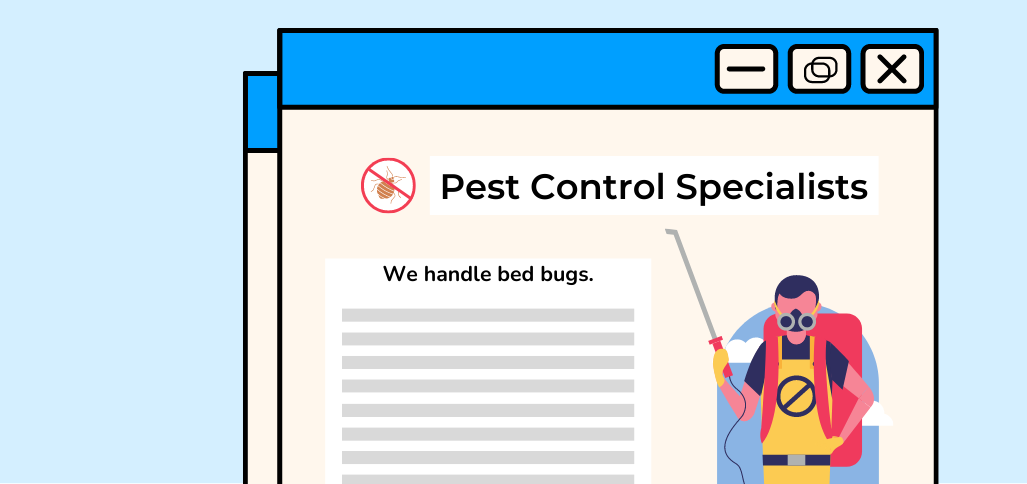
What to Do if You Find Bed Bugs in Your Apartment

*As headlines scream of a "bed bug infestation" in Paris, you may be wondering what you can do to protect yourself against these pests. In our guide below, we cover everything from identifying a bed bug problem to preventing one. *
Discovering you have bed bugs in your apartment can be upsetting, scary, and embarrassing — but if you suspect you have bed bugs, finding and identifying them is the first step to getting rid of them. One common myth spread is that if you have bed bugs in your house, that must mean it’s dirty or unsanitary, but bed bugs are just as likely to infest a clean house. In fact, one in five Americans have either had a bed bug problem or know someone who has, so it’s incredibly common and should not be associated with any shame.
If you have bed bugs, you’ll need professional help to get rid of them, but we’re here to walk you through the process of ridding your apartment of these tiny pests.
In this guide, we explain:
- How to identify a bed bug infestation
- What to do if you find bed bugs
- What your tenant rights are if you have bed bugs
- How to prevent future infestations
- Common myths about bed bugs
How to Identify a Bed Bug Infestation
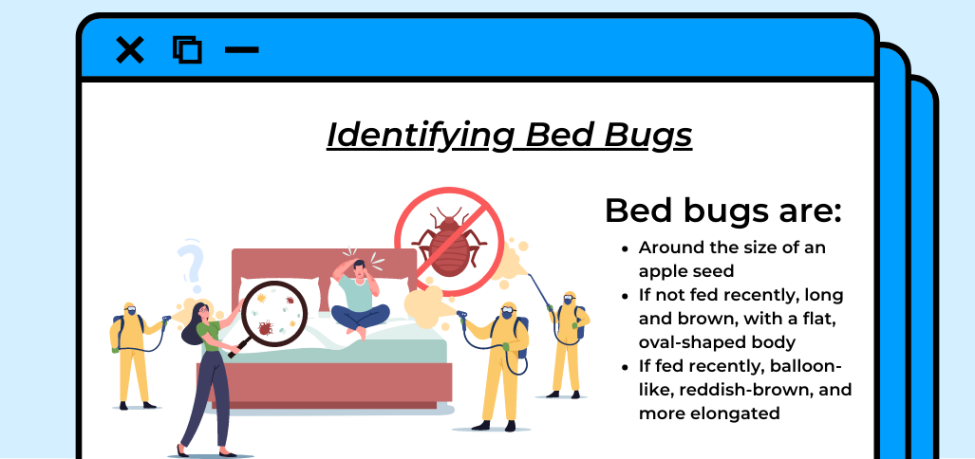
Bed Bug Bites
Bed bugs pose no serious health threat to humans, which is one reason why you shouldn’t panic if you discover an infestation. However, this means that they can be incredibly difficult to find and identify. For many people, one of the first signs they look for when trying to figure out if they have a bed bug infestation in on their own body, as bed bug bites typically leave clusters of small red spots. The Environmental Protection Agency (EPA) does not recommend relying on the occurrence of bug bites, though, because many people have little to no physical reaction from bed bug bites. Plus, the bites look similar to those of mosquitos or spiders or can mimic the appearance of other reactions like eczema or hives. That being said, if you are consistently waking up with red bug bites on your skin, especially ones that turn into itchy welts, that could be one sign of bed bugs.
Evidence in Your Home
The EPA instead recommends looking for physical signs of bed bugs in your home as a more accurate way of identifying an infestation. If you suspect that you have bed bugs in your apartment, check your mattress and bedding.
If your bed is infested, it will likely show the following signs:
- Reddish-brown stains on your mattress or bedding, which could be a sign of crushed bed bugs
- Small, dark spots on your mattress or bedding, which may be bed bug droppings
- Tiny, white eggshells
- Live bed bugs, which look like an apple seed as adults but are smaller and more translucent when young
Catching an infestation early on is key to getting it eradicated quickly. To see how far a bed bug infestation has spread, start checking around your room. Bed bugs are known for their tendency to hide in hard-to-reach places. Also check any cracks or crevices on your bed frame or headboard, as well as in the folds of curtains, in or between couch cushions, or under loose wallpaper and wall hangings when seeking out evidence of bed bugs.
What to Do if You Find Bed Bugs
It’s important to recognize that you won’t be able to solve a bed bug problem on your own, but what you can do is create a plan of action to control the infestation as soon as possible.
Dos
We recommend taking the following steps when starting bed bug treatment in your apartment:
- Tell your landlord or property manager. While each state has different laws on tenants’ and landlords’ responsibilities when it comes to removing bed bugs (which we will cover later in our guide), the first step to controlling your pest problem is always telling your landlord, preferably in writing, to begin establishing a timeline. They also may have dealt with bed bugs before or already have a method for controlling infestations, so getting them involved is a necessary step.
- Call a professional. There are many steps you can take in your home to prevent the spread of bed bugs and try to avoid bringing them back in the future, but bed bugs are notoriously difficult to get rid of. To completely remove an infestation, it often requires multiple sessions from an exterminator. Ask your landlord if they have a pest control service that they work with already for bed bugs. If not, find a licensed pest management professional who will help you determine the extent of the infestation and draft an appropriate action plan. They may need you to double bag any personal items, and empty your closets, drawers, and other spaces to aid in their exterminating process.
- Inform your neighbors. It may not be pleasant to tell others about a bed bug infestation, but if you have one, chances are that neighboring units in your apartment building are also having an issue. Check with your landlord to see if they already have a process for informing all tenants about bed bugs. If not, let them know so that they can check their own apartments and potentially prevent any further spread.
- Get a bed bug proof mattress cover. You may be tempted to buy a new mattress, but this actually isn’t necessary to stop an infestation. A plastic mattress cover with special zippers designed to stop bed bugs from passing through will do the trick when it comes to controlling the spread. The plastic cover will kill all of the bugs that are on your mattress, and prevent any more from getting in. There are similar covers for box springs you can buy. Keep receipts for anything you buy in case you are able to get a reimbursement from your landlord.
- Clean your bedding, as well as any clothing that may have been infested. Take any linens that have been exposed, then wash and dry them on high heat settings to kill any eggs. To ensure that bed bugs don’t get back into your bedding or clothing, store them in sealed plastic bags or bins.
- Vacuum thoroughly. Bed bugs can be hidden just about anywhere. Vacuuming all of the floors in your apartment, including tough-to-reach corners, under any furniture, and any of your couches and chairs is an important step in getting rid of bed bugs.
- Declutter. While bed bugs don’t discriminate, and a clean apartment can’t prevent them, clutter gives them more places to hide in. By decluttering your apartment, you can remove some of their options for hiding places. Plus, this will make it easier for your exterminator to completely rid your space of bed bugs.
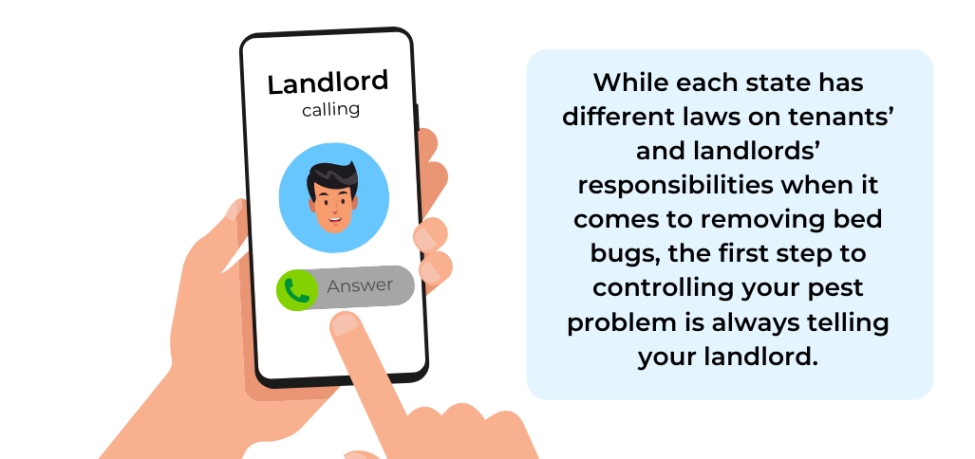
Don’ts
If panic-mode is setting in, try to relax. If you’ve already taken all of the above steps, it can be tempting to want to do more to curb the infestation sooner, but be wary of taking actions that may actually result in spreading the infections further.
Try to avoid doing the following:
- Moving your furniture to another apartment. If you know that bed bugs are in a certain room in your apartment, you may be thinking that perhaps you can save some of your furniture in other rooms from a similar fate. That’s not the case, unfortunately. Removing furniture from your place and temporarily storing it elsewhere can actually just facilitate the spread of bed bugs, since it will be hard to tell if the piece that you’re moving is completely bug-free.
- Sleeping on a piece of furniture that’s not your bed. Sleeping in a bed you know was infested with bed bugs may gross you out, but similar to the above point, sleeping elsewhere can spread the bugs to more rooms of your house. If you’ve cleaned your sheets already and covered your mattress with a bed bug proof plastic encasement, then your bed should be your safest bet. If you choose to sleep in a hotel, just make sure that you are not spreading any bugs to the hotel.
- Rely on DIY solutions. Adult bed bugs can live up to a year without eating in certain climates, and many specialists agree that they are incredibly difficult to get rid of. They spread easily and are able to hide in cracks and crevices. While doing some DIY tactics, like what we listed above, can be helpful, you must work with a professional exterminator to ensure that an infestation is fully stopped.
It may be hard to get rid of a bed bug infestation, but it’s not impossible — especially when working with the right specialist.
What Your Tenant Rights Are if You Have Bed Bugs
As we said earlier in the guide, your rights as a tenant when it comes to bed bugs depend on the state where you’re living. According to the EPA, 21 states have some level of law that applies to bed bugs. In some states, your landlord is required to house you elsewhere while they get rid of a bed bug infestation. In many, they will be required to cover the costs of ridding the infestation. However, in others, the tenant will be required to cover the cost if theirs is the only unit with a bed bug presence or the infestation is deemed to be the tenant’s responsibility.
If you live in a state where there are laws requiring your landlord to take care of bed bugs, then make sure you keep all receipts for anything bed bug–related that you purchase and keep a written timeline. You should have documentation that shows when you told your landlord about the bed bugs, any actions you took, any actions they took, and any actions taken by an exterminator.
How to Prevent Future Infestations
To prevent bed bugs from getting back into your apartment, it’s important to know how they usually get in in the first place.
Possible ways that bed bugs can be introduced include:
- On luggage, overnight bags, or folded clothes that you took to a hotel or hostel
- From a nearby or neighboring infested unit in your apartment complex
- Through used furniture picked up from the street or a secondhand store
According to the Centers for Disease Control (CDC), those who travel frequently and sleep in living quarters that have been used by other people (like a hotel or hostel) are at higher risk of spreading a bed bug infestation.
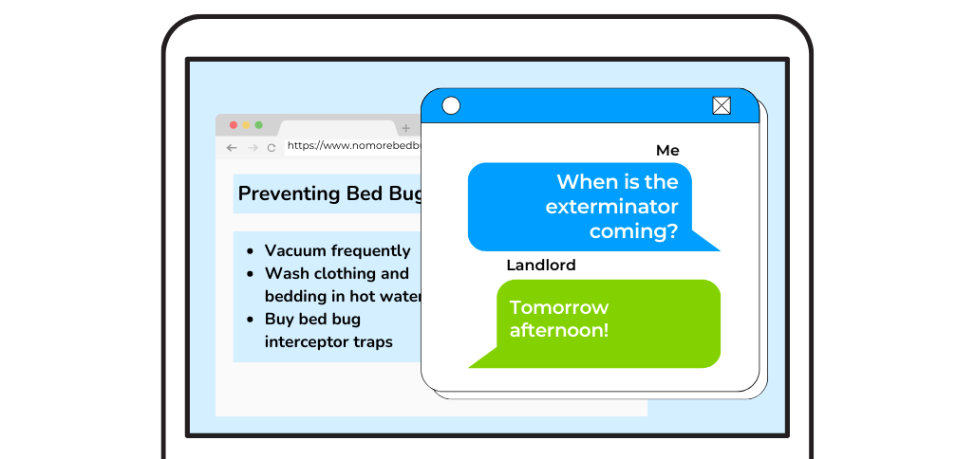
If you want to be extra cautious about bed bug control in the future, you may want to consider some of the following guidance from the EPA:
- Be wary of secondhand furniture unless you are certain it is free of bed bugs
- Vacuum frequently, especially in hard-to-reach corners
- Transport items that you washed in a shared laundry facility in sealed plastic bags, and folding your clothing at home
- Wash clothing items and bedding in hot water
- Install door sweeps on your doors and seal any cracks or crevices that you can in your apartment, like where your baseboards meet the wall
- Purchase a portable heating chamber to treat any bed bug–infested items
- Place bed bug interceptor traps under legs of furniture to catch bed bugs
There are a few widely spread, false ideas that are prevalent about bed bugs. Being informed about what’s true and what’s just a myth can help you stay vigilant when it comes to preventing or exterminating an infestation in your home.
We are here to bust the following myths, which according to sources like Scientific American and the EPA, are all untrue:
- You can’t see a bed bug with your naked eye.
- Bed bugs only live in dirty places.
- Bed bugs can transmit diseases.
- Keeping the light on will deter bed bugs from coming out of their hiding places and biting you.
- Bed bugs can fly.
- Bed bugs only bite at night.
- Bed bugs can spread by latching on to your body.
- Bed bugs only live in mattresses.
The Bottom Line
A bed bug infestation can be a scary and frustrating problem to handle, but it isn’t the end of the world. If you act quickly and vigilantly, you can rid your apartment of bed bugs and likely prevent future infestations. Just make sure that you work alongside your landlord as well as a pest control professional to ensure that you are completely ridding an infestation.
For more informative articles on all things renting, check out our Renter Guide.
Top cities
Atlanta Apartments
1,997 apartments starting at $640/month
Austin Apartments
4,754 apartments starting at $625/month
Baltimore Apartments
1,222 apartments starting at $600/month
Boston Apartments
3,491 apartments starting at $425/month
Charlotte Apartments
2,970 apartments starting at $450/month
Chicago Apartments
4,431 apartments starting at $550/month
Dallas Apartments
5,489 apartments starting at $587/month
Fort Worth Apartments
2,231 apartments starting at $555/month
Houston Apartments
5,220 apartments starting at $495/month
Las Vegas Apartments
1,048 apartments starting at $695/month
Los Angeles Apartments
11,451 apartments starting at $625/month
Miami Apartments
527 apartments starting at $995/month
Milwaukee Apartments
881 apartments starting at $465/month
New York Apartments
4,568 apartments starting at $800/month
Oakland Apartments
647 apartments starting at $995/month
Orlando Apartments
838 apartments starting at $800/month
Philadelphia Apartments
3,084 apartments starting at $500/month
Phoenix Apartments
4,271 apartments starting at $500/month
Pittsburgh Apartments
937 apartments starting at $695/month
Portland Apartments
2,551 apartments starting at $599/month
Raleigh Apartments
1,356 apartments starting at $625/month
San Antonio Apartments
3,887 apartments starting at $468/month
San Diego Apartments
2,920 apartments starting at $650/month
San Francisco Apartments
573 apartments starting at $675/month
San Jose Apartments
449 apartments starting at $1,300/month
Seattle Apartments
3,627 apartments starting at $450/month
Tampa Apartments
1,140 apartments starting at $800/month
Washington DC Apartments
2,917 apartments starting at $936/month

